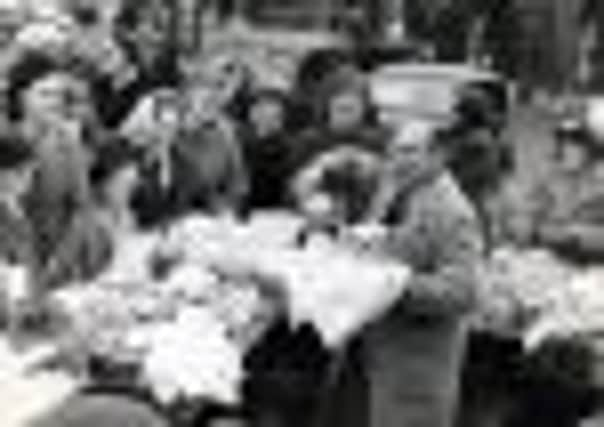Remembering the Candy Slinger and the cowboys


Some people write down their memories, put them in a drawer and forget all about them. This is what happened with market trader James Booth’s memories of the years he worked on Dewsbury Market.
Fortunately, his daughter, Kathleen Hewitt, found his memoirs after his death in 1981 and sent them to me. Recently I published the first half and this week I am recording the remainder.
Advertisement
Hide AdAdvertisement
Hide AdJames, who lived in Ravenshouse Road, Dewsbury, came from a market background – his parents had stalls on both the open and covered market.
Here is the final part of James’s memoirs in his own words:
“AMONG other characters I got to know on the market was Sammy Goldstein, known as the Candy Slinger. Lots of older people in Dewsbury will remember him when he had his stall on the road to the feast ground.
“Then there was the chap who originated from the Potteries. When he was a lad he had borrowed 7/6d from his sister and began selling a few cups, plates and basins from door to door. As he got on and his stock increased, he came up into Yorkshire and started working the markets in this area.
“Then he went travelling the fairs, and I went up and down the country with him for about three years.
Advertisement
Hide AdAdvertisement
Hide Ad“We worked a game called the ‘Wheel of Sport’ and gave crockery as prizes from as far north as Newcastle Town Moor down to Stockton, Darlington and York.
“We went to all the big fairs in Leeds and Bradford. We were at Liverpool when the late King George V opened the Mersey Tunnel.
“My colleague went on to be a bookmaker, still keeping to his market connections. He then became the managing director of a large wholesale business in Bradford.
“Later he became a councillor and then an alderman and in 1968 was unanimously nominated by the Conservative Group on Bradford City Council as the next Lord Mayor. He served with distinction in that office – Arthur Walton.
Advertisement
Hide AdAdvertisement
Hide Ad“AMONG the casual standers who came from time to time there were one or two cheap jacks and catch-penny merchants.
“One such salesman would get a crowd of people and get a penny from as many as he could by promising them a 15 jewel gold hunter watch.
“But by the time he had ended his spiel, those who had the cash were paying 10/- for a tin plated thing.
“These watches could be bought at that time at most of the wholesale swag warehouses for £1 per dozen.
Advertisement
Hide AdAdvertisement
Hide Ad“Another fellow sold candle fat as a deterrent against flies, another sold lard as a cure for corns.
“Then there was the cowboy sheriff in his garb with his two 14ft stock whips, who sold snake oil which was supposed to cure all forms of rheumatism.
“The market inspector at that time was a Mr Mountain who always had a railway timetable in his pocket.
“When any of these undesirables came and asked for a stall he’d ask him where he came from, and Manchester or Leeds would be the answer.
Advertisement
Hide AdAdvertisement
Hide Ad“He’d then look up his timetable and tell them there was a train at such and such a time, and there was no stall for him, so he’d better be off and catch it.
“These people were known by the old market and fair-ground fraternity as ‘gazump merchants’, so the word ‘gazump’ now part of the estate agent’s vocabulary, is nothing new.
“I could go on with these reminiscences for a long time, such as the second-sight performer named Suzy, who took his name from the amount of money he charged – ‘Suzy’ being a slang word for 6d.
“WHEN I first started work, the market closed on Wednesday at 8pm, and after packing all the goods away I got finished about 9pm or 9.30pm.
Advertisement
Hide AdAdvertisement
Hide Ad“I’d get 6d from my mother for my supper, and I remember the first time she asked where I was going for it, I replied, ‘The Criterion’.
“She thought it was a big hotel, but it was at the bottom of Willans Road, where the Temperance Hall is now.
“Some bill hoardings used to be there and round the corner there was a low building with a shop front, and from here pies and peas, tripe and minerals were sold.
“Through the shop and into the back one could sit down on wooden forms and have a good tuck in.
Advertisement
Hide AdAdvertisement
Hide Ad“My menu, served in a basin, was pork pie and grey peas (although the peas were brown), also a bottle of lemonade, and all this for 5d.
“Having eaten all my peas and half my pie, I had another portion of peas and a ladle of gravy put on top – this was another penny.
“This establishment was owned by a Mrs Pickles, well-known in the district for her backache plaster, and she was also the grandmother of two well-known personalities in the rag trade.
“Before I end this article I would like to say I have in my possession an old Reporter dated November 16, 1907.
Advertisement
Hide AdAdvertisement
Hide Ad“On the front page is an advert, advertising a shop owned by my father in Union Street. It says: ‘Dinner sets for sale, 26 pieces, 5/6d per set, and 40 piece tea-sets from 2/11d.’
“Just before I retired, the last 25-piece dinner service and 21-piece tea set, plus six soup bowls, I sold, were £12. What a difference in prices today.”